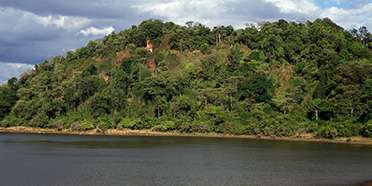- You are here:
- Home
- Countries & Parks
- Kenya Parks
- Marsabit National Park
- Reviews
- Expert Reviews
Expert Reviews – Marsabit NP

Ariadne is a renowned African wildlife photographer whose work is featured in many well-known guidebooks and magazines.
The elephants walking around the crater lake
Marsabit National Park on the mountain with the same name is home to some beautiful forested crater lakes. Buffalo, several antelope species including the secretive forest-dwelling bushbuck, sykes monkey and the black and white colobus monkey can all be seen, but it is the herd of elephants that walked around a crater lake by the name of Gof Sokorte Dika that was the star attraction for me. Sitting outside Marsabit Lodge I watched these gentle creatures walk silently from the other side of the lake all along the edge of the water towards me. It took them more than an hour to finally reach me, which added to the exciting anticipation. Afterwards I was told, they do this every day!

Philip is an acclaimed travel writer and author of many guidebooks, including the Bradt guides to Uganda, Tanzania, Kenya and South Africa.
2 people found this review helpful.
A Forested Island
Among the most remote and surprising of Kenya’s national parks, Marsabit protects the upper slopes of an isolated massif surrounded on all sides by the arid badlands characteristic of the country’s north. Mount Marsabit is volcanic in origin, and its fertile slopes are swathed in lush tropical forest and studded with ancient calderas, two of which frame permanent crater lakes, while a third hold a seasonal lake. I have often seen elephant and buffalo come to drink at these magnificently scenic lakes. Otherwise wildlife viewing is rather low-key, and the most likely reason you would visit is to break the drive northward to Ethiopia or westward to Lake Turkana, in which case it makes for a wonderfully refreshing stopover. Of interest further afield is a scattering of ‘singing wells’, named for the local Borena custom of singing while several dozen of them form a queue along up the steep walls to pass along buckets of water one-by-one.

Stuart is a travel writer and author of numerous Lonely Planet guidebooks, including 'Kenya', 'Rwanda' and 'Tanzania'.
2 people found this review helpful.
Island in the Sky
Even with the new tarmac road that currently extends halfway to Marsabit from Isiolo and the Samburu National Reserve area, travelling to Marsabit, in the far north of Kenya, is a long, bumpy and hot bounce through semi-desert acacia scrub country. But then, in the heat haze ahead rises the huge volcanic cones of Marsabit. Like an island in the sky the tops of these hills are covered in dense forest that, when the rains have been kind, can appear to glow in greens.
Home to some famously long-tusked elephants, loads of forest buffalo as well as bushbuck and leopards (which are almost never seen) Marsabit National Park is very rarely visited. In fact on my five previous visits I have never seen a single other tourist in the park. A classic driving safari would be rather pointless here as the very dense forest means animal sightings in much of the park are very rare and rather fleeting. But there are at least two large crater lakes surrounded by open marshland and when animals come out of the forest to drink they are easily seen at these. Overlooking the Gof Sokorte Dika lake is the Marsabit Lodge, a very faded place that nevertheless has charm. I have spent a couple of wonderful evenings sat on the grassy terrace here with beer and binoculars in hand watching elephants, rusty-red forest buffalo and bushbuck come down for their sundowner drink.
Every time I have visited the park the experience has been a little different and your enjoyment of the forest will rather depend on how much rainfall there has been recently. In 2011, during the worst drought in decades, the park was parched, the lakes dry, the leaves fallen from the trees and a fine shroud of dust covered everything. There were virtually no animals present and I really got the impression the park was dying. On my last visit in 2014, after a year or so of good rain, the park was re-born and compared to the deserts of the surrounding lowlands I felt like I was in the Congolese jungles so lush and green and healthy did everything appear. So, if you do make the effort of going try and go in a year when the rains have been favourable.
Average Expert Rating
- 2.8/5
- Wildlife
- Scenery
- Bush Vibe
- Birding
Rating Breakdown
- 5 star 0
- 4 star 0
- 3 star 3
- 2 star 1
- 1 star 0


 Kenya Parks
Kenya Parks